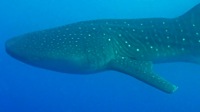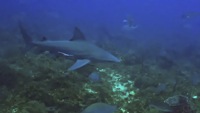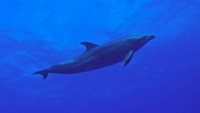 |
|||||||||||||||||||
We have come to the end of an exciting and successful expedition to find and photograph migrating whale sharks in Belize. We have had some exciting encounters with other marine creatures, too, such as dolphins, manatees, and bull sharks. The whale shark photos that we took will be donated to whale shark researchers. The photos show the unique identifying spots on each whale shark. These photos will allow other whale shark researchers to see if the whale sharks that they see have been to Belize. This knowledge will help whale shark researchers map whale shark migration routes. During our dives with the whale sharks we learned that whale sharks are not always slow-moving surface feeders. Whale sharks feed where ever they find food, near the surface of the ocean or deep underwater. We saw that the normally slow-moving whale sharks will at least double their swimming speed if they are going after their food. We learned that whale sharks are not scared of divers. We saw whale sharks swim right through a group of divers where they thought there might be food. We had whale sharks swim head-on at us, too! Even though the whale sharks were not scared of divers they were not aggressive towards divers. When the whale sharks swam through a group of divers or swam right at us they turned to avoid bumping into anyone. We learned that the there are about 1,200 manatees in Belize and they are healthy and growing in numbers. We learned that even though bull sharks are considered aggressive, dangerous sharks, in the clear waters at Gladden Spit we saw that the bull sharks were not aggressive towards us or other divers. We learned that dolphins are lazy thieves when they grab the fish off the fishermen's lines. The dolphins figured out that it is easier to take a caught fish off a line than to try to catch a moving fish. We learned that snapper gather in schools with thousands of other snappers and lay their eggs in mid-water to float away. We learned that Belize has made laws to protect whale sharks and the area at Gladden Spit where snappers come to lay their eggs. From what we learned during our expedition we expect that snappers and whale sharks will be coming to Gladden Spit for many years to come. We hope to return to Belize and have a chance to see the whale sharks, again. If you come to Belize you can see the whale sharks, too! You don't have to be a scuba diver, You can snorkel on the surface and see them, too! To learn how you could make your own Belize Whale Shark Expedition just visit our "Expedition Library" and click on the links there to learn more about the places we stayed and where we went. Thank you for joining our expedition. We hope that you learned something about whale sharks, and Belize, too!, Best Fishes,
|
TODAY'S DATA Belize City, Belize The spots used to identify each whale shark are on the left side just above the pectoral fin.
A whale shark swims through a group of divers.
Belize manatees are healthy and increasing in numbers.
A bull shark cruises by us during a dive.
An Atlantic bottle-nosed dolphin checks us out during our dive. |
||||||||||||||||||
home | basecamp | archives | library other expeditions | kids' page | cont act us © 2009, The Ocean Adventure All rights reserved. |




